|

Heritage
Main |
|
A
short history of TVA
From
the New Deal to a New Century
President Franklin
Roosevelt needed innovative solutions if the New Deal was to lift the nation
out of the depths of the Great Depression. And TVA was one of his most
innovative ideas. Roosevelt envisioned TVA as a totally different kind
of agency. He asked Congress to create “a corporation clothed with the
power of government but possessed of the flexibility and initiative of
a private enterprise.” On May 18, 1933, Congress obliged.
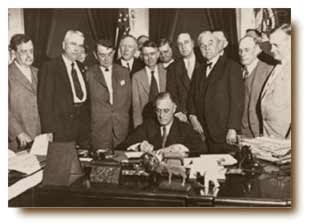 |
President
Franklin D. Roosevelt signs the TVA Act on May 18, 1933. The president
is surrounded by various members of Congress from the TVA region, and at
his left shoulder is Senator George Norris of Nebraska, after whom Norris
Dam is named. |
Right from
the start, TVA established a unique problem-solving approach to fulfilling
its mission-integrated resource management. Each issue TVA faced—whether
it was power production, navigation, flood control, malaria prevention,
reforestation, or erosion control—was studied in its broadest context.
TVA weighed each issue in relation to the others.
From this beginning,
TVA has held fast to its strategy of integrated solutions, even as the
issues changed over the years.
| TVA’s
First Board of Directors was charged with the task of implementing President
Roosevelt’s ambitious plans for the Tennessee Valley. From left to right
are Harcourt A. Morgan, Director; Arthur E. Morgan, Chairman, and David
E. Lilienthal, Director, in about 1934. |
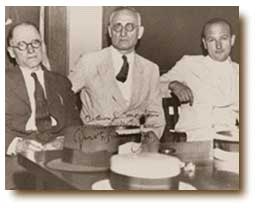 |
1930s
Even by Depression
standards, the Tennessee Valley was in sad shape in 1933. Much of the land
had been farmed too hard for too long, eroding and depleting the soil.
Crop yields had fallen along with farm incomes. The best timber had been
cut. TVA developed fertilizers, taught farmers how to improve crop yields,
and helped replant forests, control forest fires, and improve habitat for
wildlife and fish. The most dramatic change in Valley life came from the
electricity generated by TVA dams. Electric lights and modern appliances
made life easier and farms more productive. Electricity also drew industries
into the region, providing desperately needed jobs.
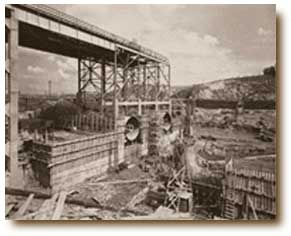 |
TVA
built dams to harness the region’s rivers. The dams controlled floods,
improved navigation, and generated electricity. |
1940s
During World
War II, the United States needed aluminum to build bombs and airplanes,
and aluminum plants required electricity. To provide power for such critical
war industries, TVA engaged in one of the largest hydropower construction
programs ever undertaken in the United States. Early in 1942, when the
effort reached its peak, 12 hydroelectric projects and a steam plant were
under construction at the same time, and design and construction employment
reached a total of 28,000.
| During
World War II, Senator George W. Norris of Nebraska, known as the Father
of TVA, said, “I have been everlastingly proud of the great contributions
TVA has made, which cannot be fully revealed until peace returns to a tortured
world.” He is shown here visiting Norris Dam. |
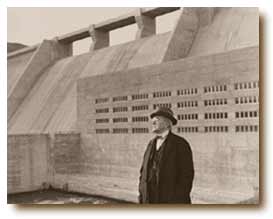 |
1950s
By the end
of the war, TVA had completed a 650-mile (1,050-kilometer) navigation channel
the length of the Tennessee River and had become the nation’s largest electricity
supplier. Even so, the demand for electricity was outstripping TVA’s capacity
to produce power from hydroelectric dams. Political interference kept TVA
from securing additional federal appropriations to build coal-fired plants,
so it sought the authority to issue bonds. Congress passed legislation
in 1959 to make the TVA power system self-financing, and from that point
on it would pay its own way.
1960s
The 1960s
were years of unprecedented economic growth in the Tennessee Valley. Farms
and forests were in better shape than they had been in generations. Electric
rates were among the nation’s lowest and stayed low as TVA brought larger,
more efficient generating units into service. Expecting the Valley’s electric
power needs to continue to grow, TVA began building nuclear plants as a
new source of economical power.
 |
A
turbine runner is installed in the hydroelectric plant at TVA’s Guntersville
Dam in northern Alabama. |
1970s and
1980s
Significant
changes occurred in the economy of the Tennessee Valley and the nation,
prompted by an international oil embargo in 1973 and accelerating fuel
costs later in the decade. The average cost of electricity in the Tennessee
Valley increased fivefold from the early 1970s to the early 1980s. With
energy demand dropping and construction costs rising, TVA canceled several
nuclear plants, as did other utilities around the nation.
| Energy
conservation became an economic necessity for homeowners and businesses
alike, and TVA became a national leader in promoting energy conservation. |
 |
To become more
competitive, TVA began improving efficiency and productivity while cutting
costs. By the late 1980s, TVA had stopped the rise in power rates and paved
the way for a period of rate stability that would last for the next decade.
1990s
As the electric-utility
industry moves toward deregulation, TVA is preparing for competition. In
recent years it has cut operating costs by nearly $800 million a year,
reduced its workforce by more than half, increased the generating capacity
of its plants, stopped building nuclear plants, and developed a plan to
meet the energy needs of the Tennessee Valley for the next 25 years.
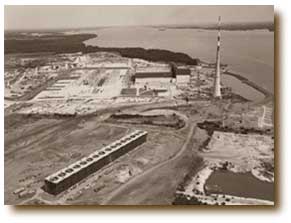 |
Browns
Ferry Nuclear Plant in Athens, Alabama, has three boiling-water reactors,
each with a generating capacity of more than 1,100 megawatts. In the summer
of 1999, TVA’s nuclear plants set new records for efficient operation and
helped the corporation meet an all-time peak demand of 28,295 megawatts
on July 30. |
Today, as the
electric power industry restructures, TVA continues to provide its core
product—wholesale electric power—competitively, efficiently and reliably.
It sets a standard for public responsibility against which private companies
can be measured.
Although TVA’s
production costs are third-lowest among the nation’s 50 largest electric
utilities, it continues to look for new ways to reduce costs even more
and improve efficiency. TVA is on track to achieve the ambitious goals
laid out in its 10-year business plan, designed to align the cost of TVA
power with future competitive rates. TVA also has initiated a Business
Transformation program to further reduce costs and is moving to more flexible
contracts with its distributor customers to meet their needs in a competitive
marketplace.
In 1998 TVA
unveiled a new clean-air strategy to reduce the pollutants that cause ozone
and smog. The initiative will cut annual nitrogen-oxide emissions from
TVA’s coal-fired plants by 168,000 tons by the year 2003. Modern equipment,
representing an investment of $600 million, will help states and cities
in the Tennessee Valley meet new, more stringent air-quality standards
while providing greater flexibility for industrial and economic growth
in the region. TVA earlier invested more than $2 billion to reduce sulfur-dioxide
and nitrogen-oxide emissions.
In short, TVA
continues to strengthen its position as an energy leader in price, reliability,
efficiency, and environmental stewardship as it helps lead the utility
industry into the 21st century.
More on
TVA history
The New Deal
Network Web site, at http://newdeal.feri.org,
has a wealth of information about the early days of TVA.
NDN’s partners
and sponsors include the Franklin and Eleanor Roosevelt Institute, the
Franklin D. Roosevelt Library, the Institute for Learning Technologies
at Columbia University, and IBM.
The site features
photographs and texts—including speeches, letters, and other historic documents—from
the New Deal period. One of the primary links is “TVA: Electricity For
All.” It includes information on the origins of TVA, the people who built
the dams, the changes that electricity meant for Valley residents, and
Lorena Hickok’s “Letters from the Field.” (Hickok was a journalist who
traveled through the Valley in June 1934 recording her impressions of area
residents’ reactions to TVA for Harry Hopkins, one of President Roosevelt’s
closest advisers, and Eleanor Roosevelt.)
For more information on TVA’s history, contact Patricia Bernard Ezzell,
TVA Historian, at pbezzell@tva.gov
or at 423-632-1582.

 |
|
|